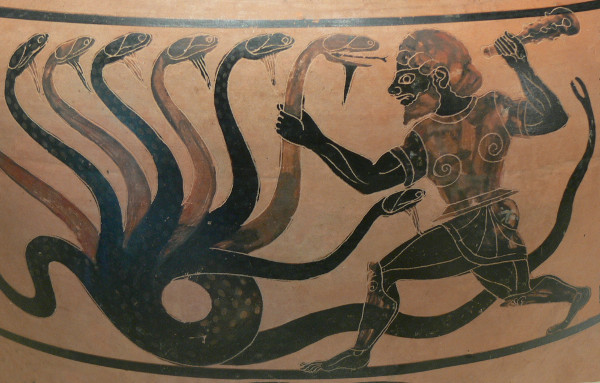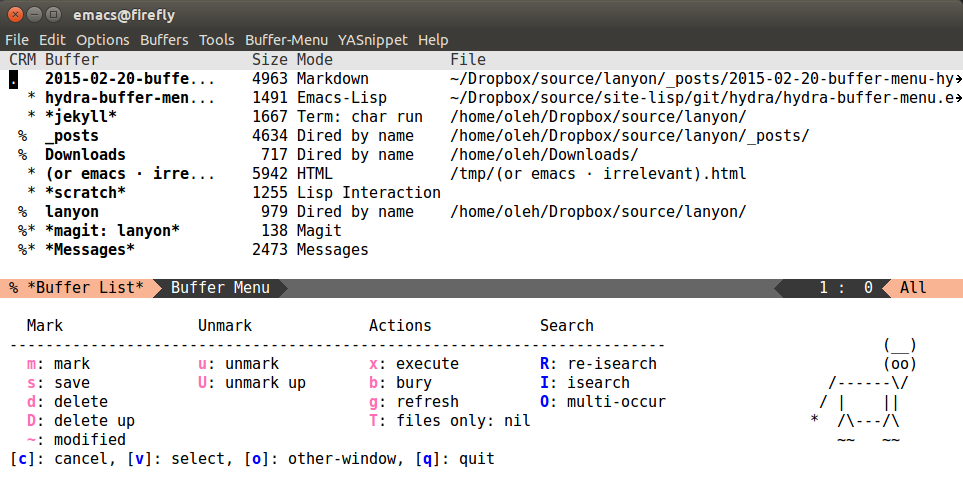This is a package for GNU Emacs that can be used to tie related commands into a family of short bindings with a common prefix - a Hydra.
Once you summon the Hydra through the prefixed binding (the body + any one head), all heads can be called in succession with only a short extension.
The Hydra is vanquished once Hercules, any binding that isn't the Hydra's head, arrives. Note that Hercules, besides vanquishing the Hydra, will still serve his original purpose, calling his proper command. This makes the Hydra very seamless, it's like a minor mode that disables itself auto-magically.
Imagine that you have bound C-c j and C-c k in your config. You want to call C-c j and C-c k in some (arbitrary) sequence. Hydra allows you to:
-
Bind your functions in a way that pressing C-c jjkk3j5k is equivalent to pressing C-c j C-c j C-c k C-c k M-3 C-c j M-5 C-c k. Any key other than j or k exits this state.
-
Assign a custom hint to this group of functions, so that you know immediately after pressing C-c that you can follow up with j or k.
If you want to quickly understand the concept, see the video demo.
Table of Contents
(defhydra hydra-zoom (global-map "<f2>")
"zoom"
("g" text-scale-increase "in")
("l" text-scale-decrease "out"))With this simple code, you can:
- Start zooming in with <f2> g.
- Continue to zoom in with g.
- Or zoom out with l.
- Zoom in five times at once with 5g.
- Stop zooming with any key that isn't g or l.
For any Hydra:
digit-argumentcan be called with 0-9.negative-argumentcan be called with -.universal-argumentcan be called with C-u.
Here's the result of pressing . in the good-old Buffer menu:
The code is large but very simple:
(defhydra hydra-buffer-menu (:color pink
:hint nil)
"
^Mark^ ^Unmark^ ^Actions^ ^Search
^^^^^^^^-----------------------------------------------------------------
_m_: mark _u_: unmark _x_: execute _R_: re-isearch
_s_: save _U_: unmark up _b_: bury _I_: isearch
_d_: delete ^ ^ _g_: refresh _O_: multi-occur
_D_: delete up ^ ^ _T_: files only: % -28`Buffer-menu-files-only
_~_: modified
"
("m" Buffer-menu-mark)
("u" Buffer-menu-unmark)
("U" Buffer-menu-backup-unmark)
("d" Buffer-menu-delete)
("D" Buffer-menu-delete-backwards)
("s" Buffer-menu-save)
("~" Buffer-menu-not-modified)
("x" Buffer-menu-execute)
("b" Buffer-menu-bury)
("g" revert-buffer)
("T" Buffer-menu-toggle-files-only)
("O" Buffer-menu-multi-occur :color blue)
("I" Buffer-menu-isearch-buffers :color blue)
("R" Buffer-menu-isearch-buffers-regexp :color blue)
("c" nil "cancel")
("v" Buffer-menu-select "select" :color blue)
("o" Buffer-menu-other-window "other-window" :color blue)
("q" quit-window "quit" :color blue))
(define-key Buffer-menu-mode-map "." 'hydra-buffer-menu/body)Looking at the code, you can see hydra-buffer-menu as sort of a namespace construct that wraps
each function that it's given in code that shows that hint and makes it easy to call the related
functions. One additional function is created and returned as the result of defhydra -
hydra-buffer-menu/body. This function does nothing except setting up the hint and the keymap, and
is usually the entry point to complex hydras.
To write your own hydras, you can:
- Either modify an existing hydra to do what you want to do.
- Or read the rules, the examples, the docstrings and comments in the source.
You can find some user created hydras and more documentation in the project's community wiki. Feel free to add your own or edit the existing ones.
Each hydra (take awesome as a prefix to make it more specific) looks like this:
(defhydra hydra-awesome (awesome-map awesome-binding awesome-plist)
awesome-docstring
awesome-head-1
awesome-head-2
awesome-head-3
...)
Each hydra needs a name, and this one is named hydra-awesome. You can name your hydras as you wish,
but I prefer to start each one with hydra-, because it acts as an additional namespace layer, for example:
hydra-zoom, hydra-helm, hydra-apropos etc.
If you name your hydra hydra-awesome, the return result of defhydra will be hydra-awesome/body.
Here's what hydra-zoom/body looks like, if you're interested:
(defun hydra-zoom/body nil
"Create a hydra with a \"<f2>\" body and the heads:
\"g\": `text-scale-increase',
\"l\": `text-scale-decrease'
The body can be accessed via `hydra-zoom/body'."
(interactive)
(hydra-default-pre)
(when hydra-is-helpful
(if hydra-lv
(lv-message
(eval hydra-zoom/hint))
(message
(eval hydra-zoom/hint))))
(hydra-set-transient-map
hydra-zoom/keymap
(lambda nil
(hydra-keyboard-quit)
nil)
nil)
(setq prefix-arg
current-prefix-arg))This can be any keymap, for instance, global-map or isearch-mode-map.
For this example:
(defhydra hydra-zoom (global-map "<f2>")
"zoom"
("g" text-scale-increase "in")
("l" text-scale-decrease "out"))awesome-mapisglobal-mapawesome-bindingis"<f2>"
And here's the relevant generated code:
(unless (keymapp (lookup-key global-map (kbd "<f2>")))
(define-key global-map (kbd "<f2>") nil))
(define-key global-map [f2 103]
(function hydra-zoom/text-scale-increase))
(define-key global-map [f2 108]
(function hydra-zoom/text-scale-decrease))As you see, "<f2>" is used as a prefix for g (char value 103) and l
(char value 108).
If you don't want to use a map right now, you can skip it like this:
(defhydra hydra-zoom (nil nil)
"zoom"
("g" text-scale-increase "in")
("l" text-scale-decrease "out"))Or even simpler:
(defhydra hydra-zoom ()
"zoom"
("g" text-scale-increase "in")
("l" text-scale-decrease "out"))But then you would have to bind hydra-zoom/text-scale-increase and
hydra-zoom/text-scale-decrease yourself.
You can read up on what a plist is in the Elisp manual.
You can use awesome-plist to modify the behavior of each head in some way.
Below is a list of each key.
You can specify code that will be called before each head, and after the body. For example:
(defhydra hydra-vi (:pre (set-cursor-color "#40e0d0")
:post (progn
(set-cursor-color "#ffffff")
(message
"Thank you, come again.")))
"vi"
("l" forward-char)
("h" backward-char)
("j" next-line)
("k" previous-line)
("q" nil "quit"))Thanks to :pre, each time any head is called, the cursor color is changed.
And when the hydra quits, the cursor color will be made black again with :post.
The :exit key is inherited by every head (they can override it) and influences what will happen
after executing head's command:
:exit nil(the default) means that the hydra state will continue - you'll still see the hint and be able to use short bindings.:exit tmeans that the hydra state will stop.
The :foreign-keys key belongs to the body and decides what to do when a key is pressed that doesn't
belong to any head:
:foreign-keys nil(the default) means that the hydra state will stop and the foreign key will do whatever it was supposed to do if there was no hydra state.:foreign-keys warnwill not stop the hydra state, but instead will issue a warning without running the foreign key.:foreign-keys runwill not stop the hydra state, and try to run the foreign key.
The :color key is a shortcut. It aggregates :exit and :foreign-keys key in the following way:
| color | toggle |
|----------+----------------------------|
| red | |
| blue | :exit t |
| amaranth | :foreign-keys warn |
| teal | :foreign-keys warn :exit t |
| pink | :foreign-keys run |
It's also a trick to make you instantly aware of the current hydra keys that you're about to press: the keys will be highlighted with the appropriate color.
The :timeout key starts a timer for the corresponding amount of seconds that disables the hydra.
Calling any head will refresh the timer.
The :hint key will be inherited by each head. Each head is allowed to override it, of course.
One value that makes sense is :hint nil. See below for an explanation of head hint.
The :bind key provides a lambda to be used to bind each head. This is quite advanced and rarely
used, you're not likely to need it. But if you would like to bind your heads with e.g. bind-key
instead of define-key you can use this option.
The :bind key can be overridden by each head. This is useful if you want to have a few heads that
are not bound outside the hydra.
This can be a simple string used to build the final hydra hint. However, if you start it with a
newline, the key-highlighting and Ruby-style string interpolation becomes enabled, as you can see in
hydra-buffer-menu above.
To highlight a key, just wrap it in underscores. Note that the key must belong to one of the heads. The key will be highlighted with the color that is appropriate to the behavior of the key, i.e. if the key will make the hydra exit, the color will be blue.
To insert an empty character, use ^. The only use of this is to have your code aligned as
nicely as the result.
To insert a dynamic Elisp variable, use %` followed by the variable. Each time the variable
changes due to a head, the docstring will be updated. format-style width specifiers can be used.
To insert a dynamic Elisp expression, use e.g. %(length (dired-get-marked-files)). If a head will
change the amount of marked files, for example, it will be appropriately updated.
If the result of the Elisp expression is a string and you don't want to quote it, use this form:
%s(shell-command-to-string "du -hs").
Each head looks like this:
(head-binding head-command head-hint head-plist)For the head ("g" text-scale-increase "in"):
head-bindingis"g".head-commandistext-scale-increase.head-hintis"in".head-plistisnil.
The head-binding is a string that can be passed to kbd.
The head-command can be:
-
command name, like
text-scale-increase. -
a lambda, like
("g" (lambda () (interactive) (let ((current-prefix-arg 4)) (call-interactively #'magit-status))) "git") -
nil, which exits the hydra.
-
a single sexp, which will be wrapped in an interactive lambda.
Here's an example of the last option:
(defhydra hydra-launcher (:color blue)
"Launch"
("h" man "man")
("r" (browse-url "http://www.reddit.com/r/emacs/") "reddit")
("w" (browse-url "http://www.emacswiki.org/") "emacswiki")
("s" shell "shell")
("q" nil "cancel"))
(global-set-key (kbd "C-c r") 'hydra-launcher/body)In case of a large body docstring, you usually don't want the head hint to show up, since
you've already documented it the the body docstring.
You can set the head hint to nil to do this.
Example:
(defhydra hydra-zoom (global-map "<f2>")
"
Press _g_ to zoom in.
"
("g" text-scale-increase nil)
("l" text-scale-decrease "out"))Here's a list of body keys that can be overridden in each head:
:exit:color:bind

